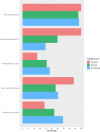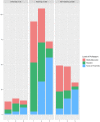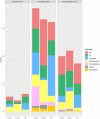Cardiopulmonary resuscitation practices in the Netherlands: results from a nationwide survey
- PMID: 31126275
- PMCID: PMC6534892
- DOI: 10.1186/s12913-019-4166-2
Cardiopulmonary resuscitation practices in the Netherlands: results from a nationwide survey
Abstract
Background: Survival rates after in-hospital cardiac arrest are low and vary across hospitals. The ERC guidelines state that more research is needed to explore factors that could influence survival. Research into the role of cardiopulmonary resuscitation (CPR) practices is scarce. The goal of this survey is to gain information about CPR practices among hospitals in the Netherlands.
Methods: A survey was distributed to all Dutch hospital organizations (n = 77). Items investigated were general hospital characteristics, pre-, peri- and post-resuscitation care. Characteristics were stratified by hospital teaching status.
Results: Out of 77 hospital organizations, 71 (92%) responded to the survey, representing 99 locations. Hospitals were divided into three categories: university hospitals (8%), teaching hospitals (64%) and non-teaching hospitals (28%). Of all locations, 96% used the most recent guidelines for Advanced Life Support and 91% reported the availability of a Rapid Response System. Training frequencies varied from twice a year in 41% and once a year in 53% of hospital locations. The role of CPR team leader and airway manager is most often fulfilled by (resident) anaesthetists in university hospitals (63%), by emergency department professionals in teaching hospitals (43%) and by intensive care professionals in non-teaching hospitals (72%). The role of airway manager is most often attributed to (resident) anaesthetists in university hospitals (100%), and to intensive care professionals in teaching (82%) and non-teaching hospitals (79%).
Conclusion: The majority of Dutch hospitals follow the ERC guidelines but there are differences in the presence of an ALS certified physician, intensity of training and participation of medical specialties in the fulfilment of roles within the CPR-team.
Keywords: Advanced life support; CPR practices; Cardiopulmonary resuscitation; In-hospital cardiac arrest; Resuscitation care.
Conflict of interest statement
The authors declare that they have no competing interests.
Figures



Similar articles
-
Hospital implementation of resuscitation guidelines and review of CPR training programmes: a nationwide study.Eur J Emerg Med. 2016 Jun;23(3):232-4. doi: 10.1097/MEJ.0000000000000296. Eur J Emerg Med. 2016. PMID: 26181002
-
Association of pharmacist presence on compliance with advanced cardiac life support guidelines during in-hospital cardiac arrest.Ann Pharmacother. 2008 Apr;42(4):469-74. doi: 10.1345/aph.1K475. Epub 2008 Mar 18. Ann Pharmacother. 2008. PMID: 18349308
-
Healthcare professionals' knowledge on cardiopulmonary resuscitation correlated with return of spontaneous circulation rates after in-hospital cardiac arrests: A multicentric study between university hospitals in 12 European countries.Eur J Cardiovasc Nurs. 2020 Jun;19(5):401-410. doi: 10.1177/1474515119900075. Epub 2020 Jan 30. Eur J Cardiovasc Nurs. 2020. PMID: 31996008
-
Part 7: Systems of Care: 2020 American Heart Association Guidelines for Cardiopulmonary Resuscitation and Emergency Cardiovascular Care.Circulation. 2020 Oct 20;142(16_suppl_2):S580-S604. doi: 10.1161/CIR.0000000000000899. Epub 2020 Oct 21. Circulation. 2020. PMID: 33081524
-
Part 4: Advanced life support: 2015 International Consensus on Cardiopulmonary Resuscitation and Emergency Cardiovascular Care Science with Treatment Recommendations.Resuscitation. 2015 Oct;95:e71-120. doi: 10.1016/j.resuscitation.2015.07.042. Epub 2015 Oct 15. Resuscitation. 2015. PMID: 26477429 Review. No abstract available.
Cited by
-
National Survey: How Do We Approach the Patient at Risk of Clinical Deterioration outside the ICU in the Spanish Context?Int J Environ Res Public Health. 2022 Oct 3;19(19):12627. doi: 10.3390/ijerph191912627. Int J Environ Res Public Health. 2022. PMID: 36231926 Free PMC article.
-
Between-centre differences in care for in-hospital cardiac arrest: a prospective cohort study.Crit Care. 2021 Sep 10;25(1):329. doi: 10.1186/s13054-021-03754-8. Crit Care. 2021. PMID: 34507601 Free PMC article.
References
-
- Schluep M, Gravesteijn BY, Stolker RJ, Endeman H, Hoeks SE. One-year survival after in-hospital cardiac arrest: a systematic review and meta-analysis. Resuscitation. 2018. - PubMed
-
- Institute of Medicine (U.S.). Committee on the Treatment of Cardiac Arrest: Current Status and Future Directions, Graham R, McCoy MA, Schultz AM, Workshop on the Treatment of Cardiac Arrest: Current Status and Future Directions (1st : 2014 : Washington DC., Workshop on the Treatment of Cardiac Arrest: Current Status and Future Directions (2nd : 2014 : Seattle W., et al. Strategies to improve cardiac arrest survival : a time to act.
MeSH terms
Grants and funding
LinkOut - more resources
Full Text Sources
Medical
Molecular Biology Databases
Miscellaneous

